Performance Over Production: Norway’s Radical Overhaul of Aquaculture Licensing and Salmon Farming Rules

Norway is rewriting the rules of aquaculture. And the changes go far beyond paperwork.
In a sweeping white paper titled Fremtidens havbruk (“The Future of Aquaculture”), the Norwegian government has proposed eliminating biomass-based licenses and replacing them with a performance-driven system that regulates environmental impact, not production volume. This is a paradigm shift — not only for Norway, but for the entire global industry that often follows its lead.
At the heart of the proposal is a bold question:
What if we stopped regulating how much fish a farm produces — and started regulating how much impact that production has?
If enacted, this would fundamentally alter how growth is permitted, how value is measured, and who gets to thrive in the next generation of salmon farming.
Let’s unpack what’s changing, what the data tells us, and what it could mean for the future of aquaculture.
From Biomass to Emissions: A New Licensing Model
Today, Norwegian salmon farms operate under a familiar system: biomass-based licenses tied to Maximum Total Biomass (MTB). Want to grow more fish? You need to acquire more biomass capacity — often at a high cost or via limited government allocation.
But under the proposed framework, that cap disappears.
Instead, growth potential will be determined by a farm’s actual environmental footprint. Metrics like sea lice emissions, fish mortality, and pollution will shape a farm’s operational ceiling. In practice, that means:
- Clean, low-impact farms could be allowed to scale.
- High-lice or high-mortality farms may be capped or even rolled back.
This is no longer about how many licenses you hold. It’s about what you do with them.
Sea Lice Quotas, Lower Thresholds, and Stricter Enforcement
One of the most consequential changes is the introduction of sea lice emission quotas.
Each production region will have a total allowable release of lice larvae, distributed as tradable quotas among farms. The biological foundation hasn’t changed — the system still models mortality exposure in wild salmon — but the tolerance level has.
The threshold for “severe impact” has been lowered from 30% to 20% mortality exposure. That adjustment alone could move more regions into regulatory red zones, restricting production regardless of historical license capacity.
For reference: In PO3, a region flagged for high impact, the Institute of Marine Research (IMR) estimated that lice emissions need to drop by 87% during the migration period just to meet the new target. Even maintaining current biomass would require massive reductions in lice levels — an operational challenge few are prepared for.
Mortality Taxes and the Cost of Lost Fish
Alongside sea lice controls, the government is proposing a new tax on fish mortality, signaling that welfare outcomes will now carry direct financial consequences.
The so-called “lost fish” tax would apply to any on-farm deaths, including escapes, adding economic weight to a problem the industry already works hard to reduce. Mortality rates across Norwegian farms have hovered around 15% in recent years. The government’s target? 5%.
That’s not a small ask. And while many farms already strive for lower losses, the introduction of a penalty system — especially one tied to performance-based licensing — adds new urgency to addressing mortality at the source.
The Real Shift: Impact Will Define Opportunity
This regulatory pivot changes the core metric of value in Norwegian aquaculture.
Previously, growth potential was defined by license volume. Large operators with multiple sites and extensive biomass allowances had the edge. But in this new framework, growth is a function of performance:
- If your lice levels are low, you can expand
- If your mortality is under control, you can operate at scale.
- If your environmental footprint rises, your production rights shrink — no matter how many licenses you own.
This realignment is likely to shift investor focus, too. Markets that once valued salmon companies based on production output may soon weigh on-farm metrics — lice counts, mortality trends, escape incidents — as key indicators of future earnings.
Winners, Losers, and the Race to Adapt
The proposal also removes the 6% cap on regional production changes previously enforced by the traffic light system. That means biomass could move faster — and in greater volume — to regions with cleaner performance profiles.
This favors:
- Well-capitalized companies that can pivot infrastructure quickly.
- Producers already investing in closed or semi-closed containment.
- Regions with strong records of environmental compliance.
Smaller farms in high-impact zones may struggle to compete, especially if quotas tighten and penalties increase. But the upside is clear: those who reduce their impact fastest will gain the most flexibility.
Case in point: systems like Eide Fjordbruk’s Watermoon semi-closed farm, which has demonstrated exceptional lice control and fish health, are exactly the kind of innovation this policy framework is designed to reward.
Looking Ahead: A Policy Meant for Performance
While some of the mechanics remain in development, the message from the Norwegian government is clear: Performance — not potential — is the new path to growth.
This doesn’t just reshape Norwegian aquaculture. It resets expectations for how sustainable farming should be defined, measured, and scaled globally.
The coming months will test how these proposals translate into practice. Thresholds will be debated. Tax structures will be defined. But one thing is certain:
For farms and suppliers alike, the license to operate in the future of aquaculture won’t be bought — it will be earned.